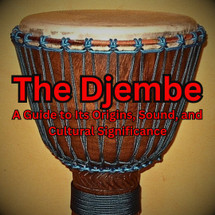Posted by Steve Head on 15th Sep 2024
The Djembe: A Guide to Its Origins, Sound, and Cultural Significance
The djembe is one of the most iconic drums in the world, known for its powerful sound, versatility, and deep cultural significance. As a percussion enthusiast and drum maker, I've always been fascinated by the unique qualities of this West African instrument. In this post, I’ll explore the history, characteristics, and impact of the djembe, and why it remains a staple in both traditional and modern music today.
A Brief History of the Djembe
The djembe drum originates from West Africa, specifically the Mandinka people of Mali, Guinea, Senegal, and Ivory Coast. The word “djembe” itself is derived from the saying “Anke djé, anke bé,” which translates to “everyone gather together in peace.” This phrase perfectly captures the communal and celebratory nature of the instrument.
Historically, the djembe was not only used for music but also held a ceremonial role in weddings, festivals, and other community events. Master djembe players, known as “djembefola,” were deeply respected for their ability to lead groups through rhythm and song, guiding dancers and other musicians in a harmonious connection.
The djembe’s bowl-shaped body is typically carved from a single piece of hardwood and topped with a goatskin drumhead. The instrument’s distinctive shape and skin tension allow it to produce a wide range of tones, making it incredibly versatile for various musical styles.
The Sound of the Djembe
One of the most captivating features of the djembe is its ability to produce a full spectrum of sounds, ranging from deep, resonant bass tones to sharp, piercing slaps. A skilled player can easily move between these tones, creating intricate rhythms that can be both uplifting and meditative.
The three primary sounds of the djembe are:
- Bass: Achieved by striking the center of the drumhead with the palm, producing a deep, resonant sound.
- Tone: Created by hitting the edge of the drumhead with the fingers and palm, resulting in a higher-pitched note.
- Slap: A sharp, staccato sound made by striking the edge of the drum with the fingers, giving the djembe its characteristic sharp accents.
What’s truly fascinating about the djembe is its ability to adapt to various musical settings. Whether used in traditional West African drum ensembles or as a solo instrument in modern compositions, its range of tones allows for great creative expression.
For those looking to explore instruments with equally rich tonal qualities, Kopf Percussion offers a variety of handcrafted cajóns, each designed to deliver a dynamic range of sounds and resonance. You can explore more about the craftsmanship behind these instruments here.
The Role of the Djembe in Modern Music
While the djembe is deeply rooted in West African culture, its popularity has spread worldwide, finding a place in numerous musical genres, including jazz, rock, and even electronic music. Its ability to blend with other percussion instruments while maintaining its distinct voice has made it a favorite among musicians looking to add unique rhythmic elements to their sound.
One of the reasons for the djembe's widespread appeal is its accessibility. Unlike many other instruments that require years of training, beginners can start playing the djembe relatively quickly. With basic instruction, players can produce quality sounds and rhythms, making the djembe a popular choice for music educators and community drum circles.
For those who are interested in exploring the world of djembes further, Djembe Direct offers a variety of djembe drums, accessories, and educational resources for players of all levels.
The Djembe and Its Cultural Significance
Beyond its musical capabilities, the djembe holds deep cultural significance. In traditional West African societies, the djembe was not just an instrument—it was a tool for communication and storytelling. Different rhythms carried different meanings and were used to mark important events like births, harvests, or the passing of a loved one.
In many ways, the djembe was—and still is—a vehicle for preserving and passing down history and cultural knowledge. The rhythms played on the djembe often tell stories of ancestors, local traditions, and the land itself. This connection to heritage is what makes the djembe such a powerful instrument, not just musically, but emotionally and spiritually.
The Rise of Djembe Circles and Community Drumming
In modern times, the djembe has become a symbol of community and connection. Djembe circles, where groups gather to play together, have grown in popularity around the world. These drum circles provide an opportunity for people to come together, regardless of skill level, and experience the joy of collective rhythm-making.
The rise of drum circles has also highlighted the therapeutic benefits of drumming. Studies have shown that playing rhythmic instruments like the djembe can reduce stress, improve focus, and create a sense of belonging and community. Many health and wellness programs now incorporate drumming as a way to promote mental and emotional well-being.
Conclusion
The djembe is far more than just a drum—it's a powerful tool for communication, cultural expression, and musical exploration. Whether you're a seasoned percussionist or just starting out, the djembe offers a world of possibilities. Its versatility, rich history, and spiritual significance make it a timeless instrument that continues to captivate musicians and audiences around the world.
As with any instrument, understanding the nuances of the djembe's sound and structure will help you get the most out of your playing experience. Whether you’re playing in a traditional African drum circle or incorporating the djembe into modern music, this remarkable instrument has a voice that transcends borders and brings people together.



